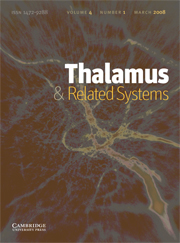Article contents
The parafascicular thalamic complex and basal ganglia circuitry: further complexity to the basal ganglia model
Published online by Cambridge University Press: 12 April 2006
Abstract
This work is focused on the study of neuronal circuits arising from the rodent caudal intralaminar nuclei and their presumed role on basal ganglia function. Emphasis was placed on the analysis of the architecture of thalamostriatal and thalamo-subthalamic projections in albino rats. Our major interest was to elucidate whether thalamic inputs were related to projection neurons or local circuit neurons within targeted structures (striatum and subthalamic nucleus). Projections coming from the parafascicular nucleus (PF) to the striatum displayed a patchy organization throughout the matrix compartment. These patches are composed by dense terminal axonal arborizations, often containing striatal neurons projecting to the entopeduncular nucleus (ENT) (medial globus pallidus in primates) and neurons projecting to the substantia nigra reticulata (SNR). The thalamostriatal projections under scrutiny were also seen to be in register with all the major classes of striatal interneurons (nitrergic neurons, neurons containing the calcium binding protein parvalbumin (PV) and cholinergic interneurons). Subthalamic neurons projecting to the ENT are the presumed postsynaptic target for fibers coming from the sensorimotor part (dorsolateral) of the PF. In summary, glutamatergic axons arising from the PF might exert a dual control of the striatal output, either by directly exciting striatal projection neurons or indirectly by means of a previous synaptic contact onto an striatal interneuron which in turn modulates the activity of projection neurons. Furthermore, thalamic inputs can also gain access to basal ganglia output nuclei via subthalamo-pallidal projecting neurons, neurons receiving glutamatergic thalamo-subthalamic projections. Thus, activation of either circuit has an opposite physiological effect on the basal ganglia output nucleus. Taken together, these data suggest that the PF may influence neuronal activity in the direct and indirect circuits and could be considered as an additional component of the basal ganglia motor loops.
Information
- Type
- Research Article
- Information
- Copyright
- 2002 Elsevier Science Ltd
- 10
- Cited by

